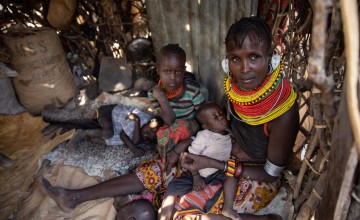
Read our 2023 annual report

Knowledge Hub
We know about the causes of hunger — but what about the effects?
At the macro-level, there’s the obvious connection between hunger and poverty. At the micro-level, Concern has also worked with millions of parents and children whose individual lives have been hit hard by hunger and malnutrition, and have heard many of those specific stories.
In this piece, we meet in the middle and look at the main effects of hunger — for adults, children, and even societies.
The effects of hunger on adults
There’s no single effect or set of effects of hunger in adults — in some cases, when an adult becomes malnourished (such as when they are pregnant or breastfeeding), it can have even an bigger impact on their children. The stakes are also higher for adults who are older or have a chronic illness or comorbidity. Generally, however, adult cases of hunger and malnutrition follow the same steps, to varying levels of severity.

The physical effects of hunger
If a human adult is keeping hydrated, estimates generally agree that they can live for up to two months without eating (if they’re not keeping hydrated, then they’re only likely to survive a few days). However, after a day or two, the body enters what’s known as “starvation mode.” In this time, the body goes through its glucose storage (what’s readily available when a person eats three meals a day at regular intervals). It then turns to glycogen from the liver and muscles. By day three, the body goes into ketosis — a point at which it begins to use fat stores for energy.
This leads to one of the most obvious physical effects of hunger in adults: weight loss due to the depletion of fat and muscle mass. This is a key symptom of malnutrition. It also affects muscle and organ function: People who are malnourished or going without food will feel overall weaker, more fatigued, and experience sensations like lightheadedness and dizziness.

Hunger also affects adult immune systems, making people more susceptible to disease. This is one of the reasons that famines can become so deadly: It’s not just about hunger; it’s also about the prevalence of illnesses (such as cholera or COVID-19). This also holds true for recovering from injuries, as the body also relies on energy stores to heal a wound or broken bone.
A 2010 paper published by the Royal College of Physicians also points to organ and system failure as a key effect of hunger. Reduced cardio-respiratory function leads to adrenal failure, largely impacting the heart, lungs, and kidneys. Gastrointestinal functions are also compromised. Paper authors John Saunders and Trevor Smith note that this includes an impact on the colon’s ability to function, which often leads to diarrhoea. Even in adults, this is “associated with a high mortality rate in severely-malnourished patients.” Without enough — and consistent — food, one of these health issues will generally prove fatal.
How hunger affects the brain
In 2018, researchers at Canada’s University of Guelph proved that “hanger” isn’t just an invented catchphrase. They linked depleted glucose levels to increased stress and depression, concluding that “hypoglycemia is a strong physiological and psychological stressor.”
PhD student Thomas Horman, who led the study, adds that “poor mood and poor eating can become a vicious cycle in that, if a person isn’t eating properly, they can experience a drop in mood, and this drop in mood can make them not want to eat.
“If someone is constantly missing meals and constantly experiencing this stressor, the response could affect their emotional state on a more constant level.”
For many people in the world’s hungriest countries, additional anxiety and stress come from hunger being an issue that affects families and whole communities. “I don't have enough food to feed myself, but it makes me feel even worse when I see the children going hungry,” says mum-of-four in drought-choked northern Kenya Lokaale Ekiru. In a response to the Horn of Africa drought and COVID lockdowns, she has been trying to make ends meet by making and selling charcoal on the roadside. Still, it only goes so far. “They always cry and follow me wherever I go if they are hungry,” she adds. “But I don't have anything to give them so I have to escape and go and make charcoal again.”

Effects of hunger on children
The first 1,000 days between a mother’s pregnancy and their child’s second birthday are a critical window for growth and nutrition, which makes hunger and malnutrition in this time all the more dangerous.
When a mother is undernourished during pregnancy, their own nutritional health isn’t the only health at stake. Complications brought on by low nutrition during pregnancy include anaemia, hypertension, miscarriages, premature delivery, and maternal death.
Effects of hunger on child development
Many children born to mothers who are undernourished will likely grow up stunted or with malnutrition themselves. Other key effects of hunger on young children include wasting (low weight for wage), low birth weight, and — in extreme cases — infant and child mortalities.
As the UNFPA points out, as these children grow up (especially girls), their options and autonomy will be equally compromised.

How does hunger affect school performance?
Education is another main concern when children go hungry. Part of the reason for this is the simple fact that it’s harder to concentrate and learn when you’re hungry. But beyond those moments in the classroom, children who suffer stunting, wasting, or other health issues that come with a lack of proper nutrients are also more likely to develop lower cognitive skills. They also are more likely to miss out on school due to chronic health issues that come from their bodies not developing properly in those critical first few years.

The cycles of hunger and poverty
All of this can lead to a cycle of both hunger and poverty. Girls who don’t get proper nutrients during adolescence and into adulthood are likely to pass on malnutrition and related deficiencies to their children.
Poverty also becomes intergenerational thanks to hunger. According to one study, children who aren’t stunted earn 22% more in their lifetimes. Another study, conducted in 2011 by Sue Horton and Richard Steckel for the Copenhagen Consensus on Human Challenges, suggests that well-nourished children are 33% more likely to escape poverty as adults.
Effects of hunger on society
Hunger’s effects go beyond individuals and families. Communities and even entire countries can suffer more during a hunger crisis.
Hunger can escalate violence and conflict
Conflict leads to hunger, but hunger can also lead to conflict. As violence escalated in Haiti through 2019, for example, the UN predicted a nearly 10% increase in hunger levels for 2020. This was before COVID-19, and by the beginning of 2021, the increase in Haitians without adequate food was closer to 20%.

Hunger breaks up families and communities
Hunger is a key cause of forced migration, influencing a family’s decision on when and where to move. In some cases, one or two family members (usually fathers and older sons) will leave in order to make money to send home, creating a knock-on effect of challenges for those they leave behind. In other cases, entire families will move and live in tenuous circumstances (often without the full legal rights and protections of refugees).
A hunger crisis can threaten local infrastructure and public health
When hunger reaches crisis levels in a region or country, the resources needed to address that emergency often go beyond what that country’s infrastructure can offer. This is especially true for health systems, which are often faced with an influx in nutrition-related cases, as well as other diseases (which, as noted above, become more frequent and severe in people who are undernourished).

Hunger can impact an entire country’s economy
In countries with high rates of hunger (many of which also have high rates of poverty), hunger can have an effect on the national economy. In Ethiopia, for example, it’s estimated that hunger contributes to GDP losses as high as 16%.
The effects of hunger: Concern's response
We won't end poverty until we end hunger. Stark evidence now demonstrates the enormous scale of nutritional issues in low-income countries, as well as their human and financial costs. As a result, Concern — like many other NGOs, as well as governments and UN agencies, has made unprecedented commitments to prioritise nutrition in our work around the globe.
Currently, our nutrition strategy is to focus efforts on reducing hunger and malnutrition among adolescent girls, women of reproductive age, and children under the age of 5. We work with adolescent girls to understand how to take care of themselves and advocate for their health and nutrition so that those who eventually become mothers bring a solid nutritional foundation to their pregnancies. We do the same with pregnant and lactating mothers, working with them to track and maintain their vitamin and nutrient levels. Some of our projects focus specifically on the first 1,000 days between conception and a child’s second birthday to prevent malnutrition in this critical time. Other programmes, like Community Management of Acute Malnutrition, screen and treat children up to the age of 5 (and even older) with overwhelmingly positive results and standard-setting cure rates.
A few other ways Concern fights hunger include:
- Supporting nutrition-sensitive agriculture and crop diversity to ensure that families have the full range of nutrients they need
- Promote nutrition-sensitive social protection and natural resource management, placing nutrition and health at the forefront of responses to other emergencies such as climate change and conflict
- Working towards gender equality and gender transformative programming
- Working towards improving access to water and sanitation services, while also promoting optimal nutrition, health, and hygiene behaviors
- Increasing access to quality education, especially for girls
- Strengthening local and national health systems so that they can deliver integrated nutrition services (such as CMAM) without ongoing support from Concern




